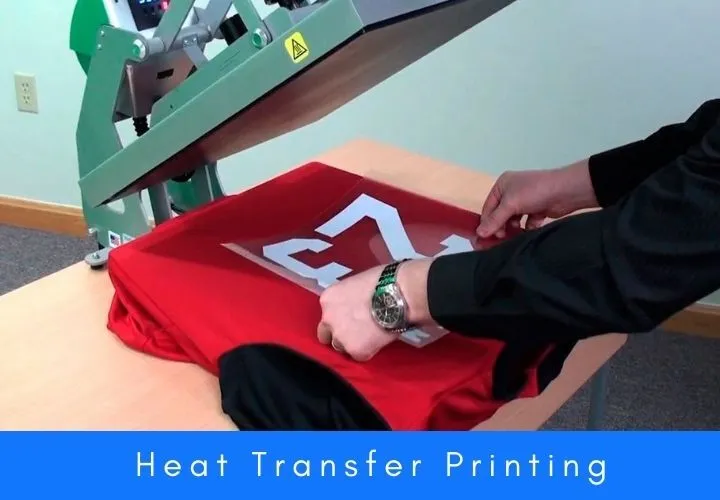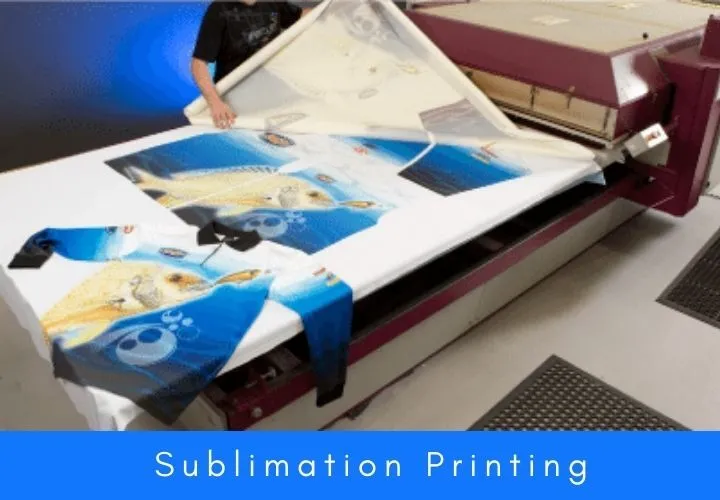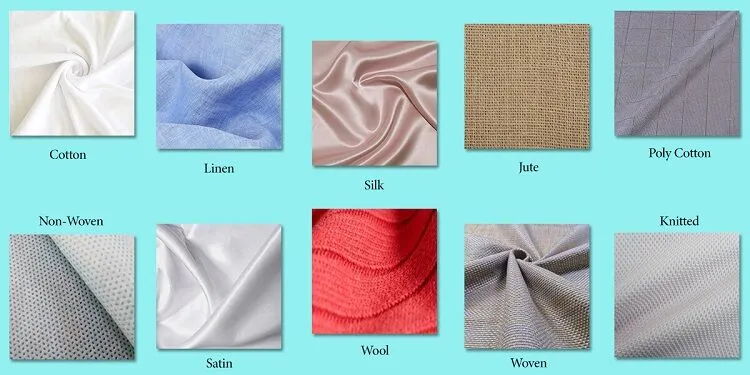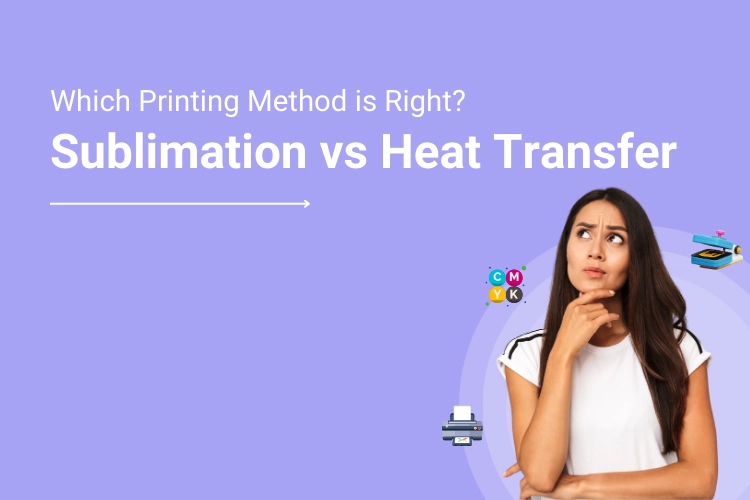The print business is a thriving space to be in right now — people are always on the lookout for customized products, and high-quality stationery, wearables, and accessories with unique designs are trendy.
Besides, according to a Smithers report, the global printing market is predicted to be valued at $821 million this year. The technology used by printers is also changing — whether it is web-to-print solutions or printing techniques.
If you are planning to add personalized garments to your product portfolio, there are two sublimation and heat transfer printing methods that you can opt for — heat transfer printing and sublimation printing.
Both have their respective pros and cons, and you can choose either as you like. Here is a short guide to help you decide on your online design studio:
What is Heat Transfer Printing?

Heat transfer printing uses a particular type of paper that transfers a printed design to a garment surface when the heat is applied. You use a laser or inkjet printer to print the design onto the heat transfer paper.
It is then placed on the garment surface and pressed with a heat press (a home iron will do at a pinch too). Afterward, the paper is peeled off, and the image adheres to the garment surface. Is it not fascinating?
Heat transfer printing is one of the simplest and cheapest ways to start with custom garment printing, and many print businesses begin with just the printer they have at home. It is the perfect choice for home entrepreneurs.
What is more — you can use this method for both cotton and polyester fabric and both dark and light-colored garments.
Read Later: Digital Vs Direct Mail Marketing: Guide to Choosing the Right Option
What is Sublimation Printing?

The sublimation printing process is almost like that of heat transfer printing — the design is printed onto sublimation paper, to which heat is then applied. The difference is in how the science of sublimation works.
When you heat sublimation ink, it turns into a gas from a solid-state and embeds itself into the fabric. Once it cools, the gas goes back to solid but becomes a part of the material permanently.
Your transferred design feels the same as the rest of the garment — there is no added layer on top. The design is also highly durable and can last as long as the garment itself under regular conditions.
Sublimation printing can only be used on polyester garments (not cotton), but you can also use it on hard objects with poly-coating, such as mugs, jewelry, or coasters.
Request a Demo Now: Unlock the Power of Personalization with Our Sublimation Design Software
Difference Between Sublimation and Heat Transfer Printing
When you start in the garment printing business, it is best to pick one of these two sublimation vs heat transfer printing methods and invest in it. Here, we discuss the start-up considerations for each to help you choose wisely that is both efficient and economical:
1. Costs and equipment
Heat transfer printing is exceptionally cheap to start with, as you can make do with any inkjet or laser printer you have at home.
Besides, you will need the heat transfer paper, the garments you will be decorating, and a heat press, which you can get for around $300 to start with.
Sublimation printing is more expensive by contrast, although it has reduced in recent years, and the cost of the heat press remains the same.
A cost-effective option is to invest in a sublimation printing starter kit, which comes with the sublimation printer, the paper, the necessary product designer tool, and a sample set of products to print on.
2. Feel and durability
With sublimation, the printed design becomes an actual part of the fabric rather than a layer on top, which means you get a superior feel to the garment and unmatched durability.
With heat transfer printing, you can feel the layer on top, and it can get cracked or faded with multiple washes. However, by investing in higher-quality heat transfer papers and an online web to print designer, you can achieve and sell print items with a softer feel and more durability — relatively quickly.
3. Types of garments you can make

Sublimation ink will only bind to polyester material, so you cannot use it on 100% cotton garments. You can work with poly-cotton materials to some extent, but the transfer quality would not be quite as vibrant.
Plus, since sublimation does not involve any extra layers on top of the fabric, you need to work with white or light-colored garments for the design to show up clearly.
On the other hand, heat transfer printing works for garments in all colors and polyester, cotton, and blended fabrics.
4. Colors produced
Sublimation printing lets you pick full colors, making it ideal if you want to create a specific design, like a brand logo or a photograph. Heat transfer printing may not always produce the same full-color effect.
If you want to print photos or logos through heat transfer, you will need to invest in higher-quality heat transfer paper. Inkjet transfer papers are typically your best bet for photo printing. Implement a web to print software and start selling today!
5. Weeding
With sublimation printing, the design is directly transferred to the fabric, so the process is naturally self-weeding. Heat transfer papers are typically not self-weeding except for certain “two-step” laser transfer papers.
That means that with most heat transfer papers, there will be a prominent background in the paper’s shape around the design.
You will need to trim around the image to get rid of this background, particularly for dark-colored fabrics where it will show up clearly. With white or light-colored fabrics, the background is less visible, although you will still be able to feel it physically.
Heat Transfer vs. Sublimation: Choosing the Right Printing Method for Business
According to us, sublimation printing is the perfect choice for you if you want your printing business to scale massively. But if budget is an issue, then heat transfer printing is not a bad option either.
In the print industry context, having an online web2print design tool can make all the difference. The innovative technology will help you set up an eCommerce storefront, and you can sell multiple custom print-ready templates for products you like to your customers.
FAQs on Heat Transfer and Sublimation Printing
Which materials are suitable for sublimation printing?
Sublimation printing works best on polyester fabrics or items with a polymer coating, such as mugs, phone cases, and mousepads.
Can I use sublimation on cotton fabrics?
Sublimation doesn’t work well on natural fibers like cotton because it requires polymers to bond with the dye. However, there are blended fabrics available that contain both polyester and cotton.
What types of designs are suitable for heat transfer printing?
Heat transfer is versatile and suitable for various designs, including graphics, text, and photographs.
Is one method more durable than the other?
Sublimation printing tends to be more durable since the ink becomes part of the material, while heat transfer printing may fade or crack over time, especially with frequent washing.
Which method is better for intricate designs?
Sublimation printing offers better results for intricate designs due to its ability to capture fine details and produce high-resolution images.
Can I print on dark-colored garments using sublimation?
Sublimation works best on light-colored materials, requiring a white or light background for the colors to appear vibrant. Heat transfer with special opaque transfer papers is more suitable for dark garments.
Which method is more cost effective for small quantities?
Heat transfer printing is usually more cost effective for small quantities since it doesn’t require the specialized equipment and setup that sublimation does.
Can I use both methods for my printing business?
Many businesses use sublimation and heat transfer methods to offer their customers a wider range of customization options.
More for you
- Top 8 Print MIS Software in 2024…Read More→
- Top 10 Wholesale Promotional Product Suppliers in the United States…Read More→
- 9 Best Screen Printing Machines of 2024…Read More→
- Top 5 Print Estimating Software…Read More→
- The Best Large Format Printers of 2024…Read More→
- The Top 10 DTG Printers (Direct-To-Garment) With Prices…Read More→
*This post has been updated on Dec 2023.




